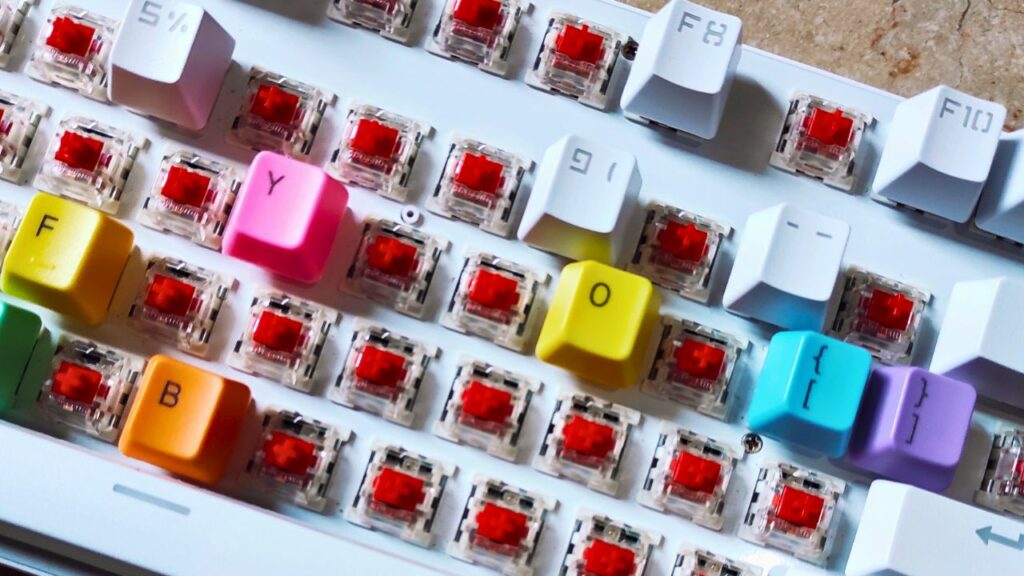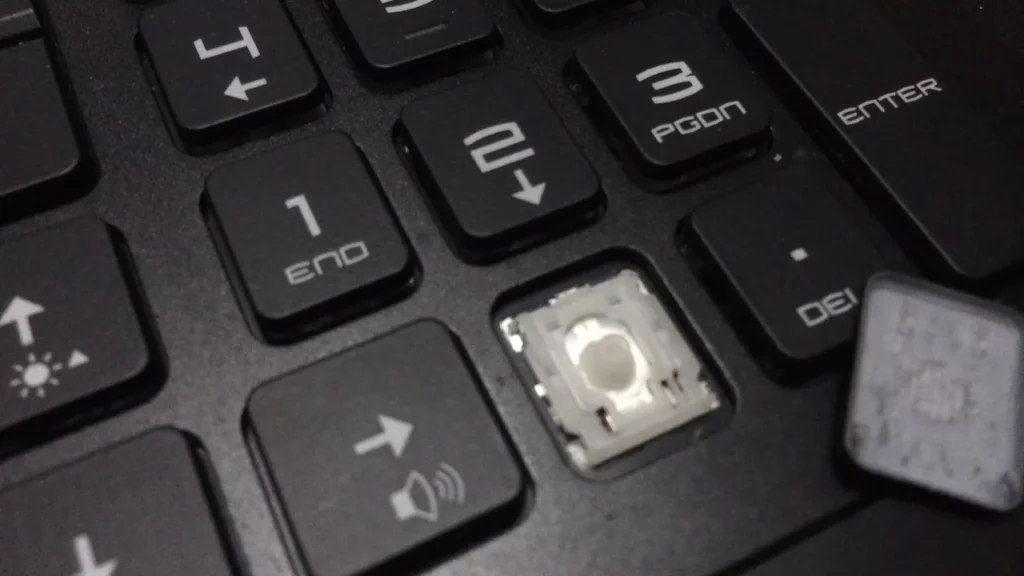From the nostalgic clicks of a typewriter to the smooth keystrokes of today’s high-tech gaming setups, keyboards have been our faithful companions in navigating the digital world. Today, let’s delve into an aspect that makes or breaks our keyboard experiences – keyboard switches. We’ll discuss two popular kids on the block: scissor-switch keyboards and mechanical keyboards. Whether you’re a casual typer or a gaming enthusiast, understanding these switches can significantly enhance your keyboard interaction.
Understanding Keyboard Switches
Think of keyboard switches as the unsung heroes of your keyboard. Each key on your board has its own little support system—a switch that springs into action the moment you press down. This isn’t just about how your keyboard feels under your fingers, but also how it responds to your input, almost like it’s reading your mind.”
“The type of switch nestled under each key can make a world of difference, and not just in the feel-good factor. It plays a crucial role in how responsive your keyboard is to every tap and touch. So next time you’re typing away, spare a thought for these tiny marvels working tirelessly beneath each key!
Discover the World of Mechanical Keyboards

Mechanical keyboards are often associated with a tactile feel and a distinctive click or bump when a key is pressed. This feedback can make typing more satisfying and potentially increase accuracy for some users. Mechanical keyboards are also known for their durability and robust construction. They can withstand heavy use without sacrificing performance, making them a favorite among gamers and professional typists.
But what truly distinguishes mechanical keyboards is their unparalleled potential for customization. You have the freedom to tweak the actuation point—this is the travel distance a key needs to cover before it’s recognized. Additionally, you can swap out keycaps, set up macros, and even make choices between plate mount and pcb mounted switches. It’s like being given a paintbrush and a blank canvas – you’re in control of creating your masterpiece. But keep in mind, this level of personalization often comes with a bit heftier price tag.
Scissor Switch Keyboards

On the other side of the keyboard spectrum are scissor-switch keyboards. These offer a low-profile design requiring less pressure to register each keystroke. The result? A streamlined typing experience that sits comfortably between the soft touch of membrane keyboards and the tactile feedback of mechanical ones.
Scissor-switch keyboards also boast an advantage in terms of cleanliness as they are more resistant to dirt and debris due to their closed structure. This makes them a great option for those who prioritize minimal maintenance.
Scissor Switches versus Mechanical Switches: Price Point Comparison
When it comes to the price tag, you might find that mechanical keyboards generally carry a heavier one compared to scissor-switch types. This is no surprise considering their detailed craftsmanship and the choice to customize them to your liking. But don’t let that put you off! For those of you who are new and curious about the mechanical keyboard scene, there are budget-friendly starter options waiting for you. So why not take that plunge into the world of mechanical keyboards
Scissor-switch keyboards generally fall somewhere in the middle in terms of price – more expensive than most membrane options but cheaper than high-end mechanical models.
Performance Breakdown
Performance-wise, both types have their strengths. Mechanical keyboards offer precise actuation due to responsive switches while scissor-switch keyboards offer consistent performance across keys thanks to their uniform design.
Keep in mind though that not all switches are made equal – quality can vary greatly depending on specific design and build standards set by manufacturers.
Let’s delve into some real-world examples where one type of keyboard might be favored over the other:
Gaming: Mechanical keyboards reign supreme here thanks to their tactile feedback, N-key rollover feature (allowing multiple simultaneous key presses), and customization options that enhance gameplay.
Office use: Scissor-switch keyboards are often preferred for office settings due to their quiet operation and slim design conducive to portable setups like laptops.
Data entry: Fast typists or data entry professionals might lean towards scissor switches for their reduced key travel which allows rapid keystrokes without significant finger strain.
Aesthetics and User Experience

While performance is crucial, aesthetics and user experience shouldn’t be overlooked when choosing between scissor-switch and mechanical keyboards.
Mechanical keyboards have an undeniably retro appeal with their chunky keys and audible clicks. They also accommodate more ergonomic designs with curved layouts or split sections to reduce wrist strain.
Scissor-switch keyboards favor sleekness with their slim profiles and quiet operation. Their lower key travel makes them ideal for faster typing speeds without finger fatigue.
Understanding the Technology Behind the Keys
To truly appreciate the difference between scissor switches and mechanical switches, it helps to understand how each type functions.
Mechanical Switches
Each key on a mechanical keyboard is built over a switch consisting of a base, spring, and stem. When you press a key, the stem pushes down on the spring, triggering an electrical signal that registers your keystroke. The heavy-duty construction of these switches contributes to their durability and distinct tactile feedback.
Scissor Switches
Scissor-switch keyboards operate quite differently. Their keys are attached to two plastic pieces that interlock in a ‘scissor’ arrangement. When you press a key, these pieces compress, registering your input. The design allows for a shorter travel distance and quieter operation compared to mechanical switches.
Maintenance Considerations
Maintenance is another factor worth considering in this comparison. Mechanical keyboards, due to their open switch design, are more prone to dust accumulation which can affect performance over time. However, many models offer removable keys for easy cleaning or replacement.
Scissor-switch keyboards are less susceptible to dust due to their closed structure but can be harder to clean if debris does get inside. Replacing keys can also be more challenging due to the intricate scissor mechanism.
Frequently Asked Questions
Can I customize my scissor-switch keyboard like I can with a mechanical one?
While customization options exist for scissor-switch keyboards such as adding silicone key covers or stickers, they don’t provide the same level of personalization as mechanical ones where you can change out individual keys or adjust actuation points.
Which type of keyboard is better for gaming?
Generally speaking, many gamers prefer mechanical keyboards for their tactile feedback, responsiveness, and customization options which enhance game-play experiences.
Are scissor-switch keyboards quieter than mechanical ones?
Yes! Due to their construction design which minimizes noise-producing vibration, scissor-switch keyboards tend to operate much quieter than most mechanical models.
Which type of keyboard lasts longer?
Typically, mechanical keyboards have a longer lifespan due to the robustness of individual switches which are designed for extensive use without degradation in performance.
The Verdict?
Choosing between scissor-switch and mechanical keyboards ultimately boils down to personal preference. If you’re looking for tactile feedback and customizability options, mechanical might be your way to go. However, if you prefer a quieter typing experience with consistent performance across keys, then scissor-switch might be more up your alley.
Either way remember this: whether you’re grinding out an essay or conquering virtual worlds, your keyboard should be as unique as you are!